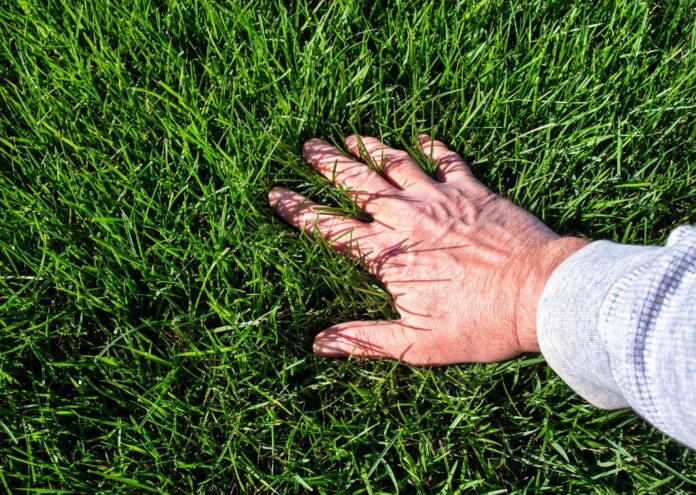There are three types of homeowners: their lawn is their pride and joy, lawn care is not their priority, or they don’t know how to take care of their lawns (yet). Lucky for you we created a quick guide on how to get a green lawn with just six simple steps.
Read on so your yard is no longer the neighborhood eyesore.
Green Lawn Guide
- Remove Weeds
- Sharpen Lawn Mower Blades
- Set Your Lawn Mower Blade Height
- Fix Soil pH
- Bag Grass Clippings
- Keep Grass Hydrated
- Fall Lawn Maintenance
- Lawn Cutting Myths
How to Get a Green Lawn Guide
These six simple steps will teach you how to get a green lawn without tons of effort or money. In fact, most of these steps cost nothing at all and will get you that green lawn in no time.
Remove Weeds
Removing weeds is the best place to start for lawn maintenance because weeds are unsightly, they can deprive grass of its nutrients, and weeds can shield grass from sunlight and prevent growth.
When it comes to removing weeds the most popular methods are to use conventional weed killer sprays and treatments, pull out/remove weeds and roots, or natural weed-killing remedies such as pouring boiling water onto weeds.
We talk more about this in fall lawn maintenance, but once weeds are removed you can assess your lawn’s soil and address lawn patches.
Sharpen Your Lawn Mower Blades
I know what you’re thinking and – yes! You can sharpen your lawn mower blades. In fact, you need to! And if your lawn mower blades are dull it may be the #1 thing stopping you from having a green lawn.
There are two main reasons why you need to sharpen your lawn mower blades:
- Grass cut with dull blades can require two or more passes with the lawn mower.
- Dull blades break grass instead of cutting it, which can cause grass to brown. So not only is your grass cut poorly, it’s an ugly color too.
Don’t know how to sharpen your lawn mower blades? Check out this Universal Lawn Mower blade sharpener.
Set the Correct Lawn Mower Blade Height
If you want to know how to get a green lawn all season long then you need to know which height to set your lawn mower blades to.
In the spring and fall set your lawn mower height to one inch. Grass tends to grow the fastest in spring so keeping your grass short will allow you to go longer between each time you mow. Grass grows slower when temperatures drop in the fall, and leaves fall; keeping the grass short allows your mower to cut and mulch the leaves together.
In the summer set your mower height to two inches minimum. When summer temperatures consistently reach over 85°F grass can get stressed and need to be cut more frequently to prevent it from turning brown.
Yes, you need to cut your grass more often at a taller height, but that’s what’s best for it in the summer season.
Fix Your Soil’s pH
Your soil’s pH refers to the amount of water soluble chemicals and nutrients in your lawn. A soil pH analysis can tell you exactly how to get a green lawn by telling you if your soil is more acidic or alkaline.
How to Test Soil pH
- A lab-ordered or at-home soil pH test kit.
- Plant hydrangeas – the color of this plant’s petals changes based on soil pH. While hydrangeas can’t tell you what nutrients your soil needs, the color can alert you of changes in soil (but if you murder anyone don’t bury a dead body under your hydrangeas).
How to Fix Soil pH
- Add lime to increase soil pH.
- Add elemental sulfur to lower soil pH.
Bag Grass Clippings
You have learned how to get a green lawn with the above five simple steps. Now clean up your grass clippings so you don’t ruin all your hard work!
There is some back and forth about bagging or leaving your grass clippings. The argument for leaving your grass clippings is that grass breaks down and becomes a natural fertilizer. However, it takes time for grass clippings to decompose.
I encourage people to bag their clippings because clippings block the sun from reaching the grass, they don’t quickly decompose, and it doesn’t look or feel good. I actually spend less time in my yard if my shoes or feet are getting covered in grass clippings.
If natural fertilizer is important to you then I recommend composting your grass clippings.
Keep Grass Hydrated
This is a no-brainer. Grass is a plant and it’s a pretty thirsty one too. Depending on where you live your regular rainfall may be enough. However, droughts are common in the summer or you may live in a dryer climate. If so, you’ll need to regularly water your grass to keep it green.
If you live in a dryer climate I suggest you choose a drought-resistant grass or ground cover.
Keep Grass Green with Fall Lawn Maintenance
You’ve learned how to create a green lawn during spring and summer. Now you need to learn how to set yourself up for a green lawn next season.
These are our favorite year-end lawn maintenance steps for the fall.
- Rake Fall Leaves – grass can suffocate and die if trapped under fall leaves, especially if left over winter.
- Fertilize Your Lawn – Fall is the best time to fertilize your lawn and the best time to do it is about six weeks before the first frost.
- Repair Patches & Thin Lawns – Fall is a great time to overseed thin areas of grass and address bare patches, particularly in cool-season areas like Chicagoland. The temperature is ideal for germinating and setting you up for optimal spring growth.
These are just our top three fall lawn care tips. Tell us in the comments what lawn care steps you take each fall.
3 Lawn Care Myths
Not everything your neighbor says is true. Here are popular lawn care myths that will NOT help you get a green lawn.
Myth #1: “Cutting your lawn in the same direction every time will create divots.”
Not if you have a push mower.
While it won’t hurt to change up the direction you mow your lawn each time, there is no benefit to it aside from you discovering your personal preference.
Myth #2: “The best grass fertilizer is…”
I know, we just mentioned the importance of fertilizer in our steps for how to get a green lawn – and fertilizer is important! But no one brand is the best fertilizer because soil quality varies, even between neighbors.
For example: My house is a newer construction compared to my neighbor’s home. My yard could have more clay and a different composition all-around because of when and how my yard was dug up before construction.
Assess your soil before picking a fertilizer. Here are three quick things you can do:
- Visual Soil Analysis – dig up a 20 cm hole and visually inspect your soil. If you’re not sure what to look for you can learn more from Science Learning Hub.
- Test Your Soil – at-home soil test kits are available on Amazon.
- Test Your Soil’s pH – at-home soil pH test kits are available on Amazon.
Myth #3: “Weed killer is the best way to treat your lawn.”
Chemical and synthetic weed killers may kill unsightly plants and weeds, but they don’t address what’s causing these weeds to grow. Without addressing the why, weeds will return.
Your Tips for Creating a Green Lawn
These are just the steps we swear by for how to get a green lawn year-round. Dan and I are also from the Midwest and we primarily know what works best here. Leave a comment with the tips you swear by for maintaining a green lawn.




